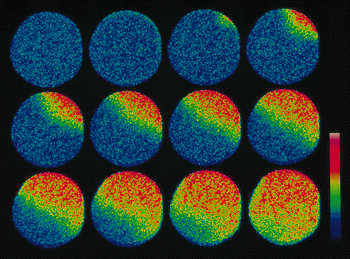The first open door on the fifth floor belonged to Dr. Grant Johnson, Associate Professor. His lab door was open but bore a sign warning "CAUTION, LASER LIGHT". Dr. Johnson was leaning over a thick steel plate on large bench positioned in the middle of the room. Attached to the plate were several three-foot-long V-shaped metal rails with clamping devices holding lenses, prisms, optical grating and modular light detectors. It was a home-made set-up on an "optical bench".
 "You can't come in for a couple of minutes," he said. With a small hexagonal wrench, he adjusted a lens. "I've been working all morning on lining this gizmo up."
"You can't come in for a couple of minutes," he said. With a small hexagonal wrench, he adjusted a lens. "I've been working all morning on lining this gizmo up."
Dr. Johnson hummed to himself as he leaned his thin, fiftyish torso over his project, revealing a bald spot on the top of his head of dark straight hair. His skin was pale, as if he had spent too much time in the lab. Taped to the wall over his gizmo was a cartoon of a German professor. The cartoon prof looked like Albert Einstein after someone had sat on his violin -- hopping mad. The caption read:
Diese Machine ist for Science-Experimenten und nicht for Finger-Poken und Button-Button-Pushen und Knobben-Turnen. Venn diese Rubber-Necken- Dummkopf-Sight-Zeers gepoken und gepushen und geturnen, zenn geht die Machine KAPUTT. Just relaxen und gelooken zu die Blinken-Lights.
A germanophile! A Swarthmore prof once told me that all scientists are supposed to know a little German and that some regard proficiency as a mark of distinction.
After a couple of minutes, Dr. Johnson looked up. His bench optics might have been straight, but his thick plastic glasses were not. The wire frames were crooked and a large lump of solder bulged over the bridge of the nose, the obvious result of an in-lab repair.
"Now my gizmo's lined up pretty good. Can you give me a piece of paper from your notebook?"
"Sure," I said, stepping up and tearing out a sheet. He took it, then gestured me back.
"Just stand back until I do my test shot." Dr. Johnson knelt at the end of the bench and looked through a small hole in a metal disc.
"Yeah, looks like the line-up is pretty good." He tore off a strip of paper and fixed it on the disc with adhesive tape. "Now watch, but stand back. Five, four, three, two, one, zero!"
Then I heard a click, zap and slap. For a split second, thin rods of bright red light flashed over the set-up. The paper gave off a small puff of smoke. Dr. Johnson leaned over and inspected the burn hole carefully.
"Well, it looks like I got the right hole! Here, you can have it back as a souvenir. Now, what can I do for you?"
"I'm Ben Candidi. I'm starting next week as a graduate student. I wanted to talk with you about your research."
"Well, Candidi, here it is," he said with a sweeping gesture that took in the whole lab. "You just saw my laser excitation system. I stick fiber optic cables into that little hole and pure monochromatic light comes out the other end. So my laser can pump photons into any experiment I've got going here. Hell, I could pump photons to Stampawicz down the hall if he'd get me a cable that's long enough!"
He rattled off this string of jargon in an un-selfconscious Ohio twang. He pointed to a large black box with an irregular array of precision dials, identifying it as a "fluorescence lifetime apparatus". He identified an instrument-encrusted microscope as his "fluorescent microcytometer". I asked him what he used the microscope for.
"To tease secrets out of a single cell using photons without blasting its head off," he said, as if that were the simplest thing in the world.
"How do you do that?"
"I focus a strong pulse of laser light through a microscope to blast the fuck out of these dye molecules holding calcium in the cell. So the dye releases the calcium into the cytoplasm. Then, a millisecond later, I switch on a weak beam of light and measure calcium binding to the proteins in the cell - you know, molecules like calmodulin."
I didn't know. But I kept asking him "intelligent questions" and he told me what's calmodulin and how he measured calcium with the fluorescence of an entrapped dye molecule called Fura-2. He concluded by saying that his experiments told "a helluvalot" about the molecular calcium pumps in the cell membranes.
Illustration is of fluorescence microscopy of calcium inside a living cell: Confocal images taken at 5-second intervals of a fertilization-induced calcium wave in a Pisaster ochraceus starfish oocyte that was microinjected with Calcium Green-1 10,000 MW dextran (C-3713).
Experiment conducted in laboratory of
Dr. Stephen A. Stricker
Department of Biology
University of New Mexico.
Copyrighted illustration used with permission of Molecular Probes, Inc. which manufactures the calcium indicator dye.
Return to characters page